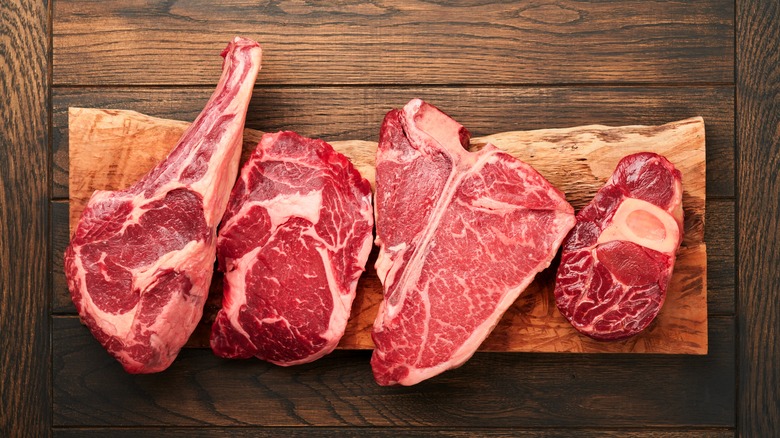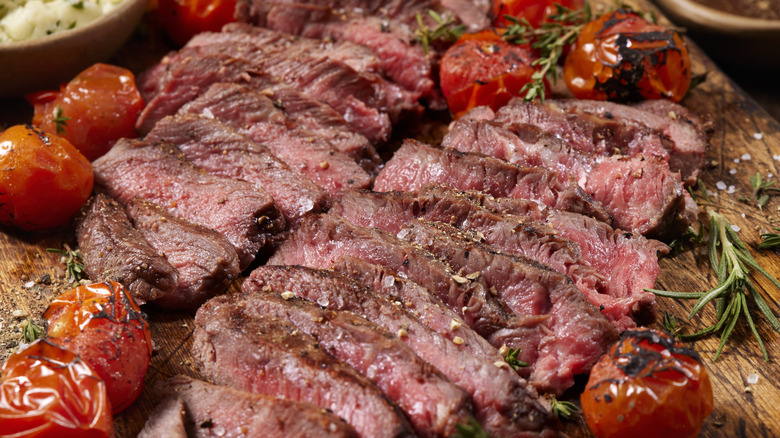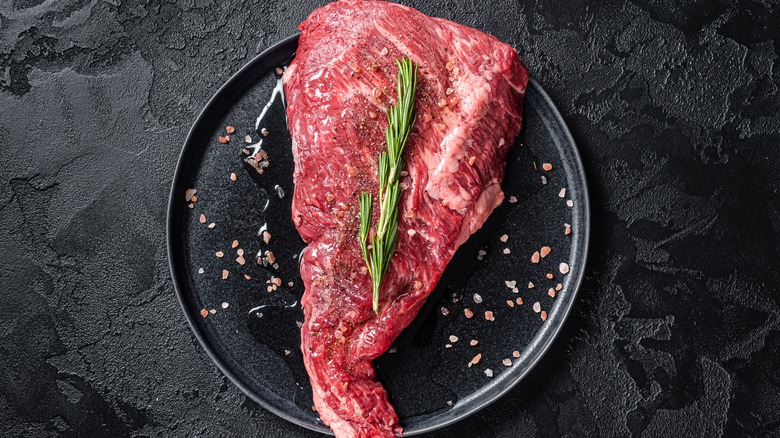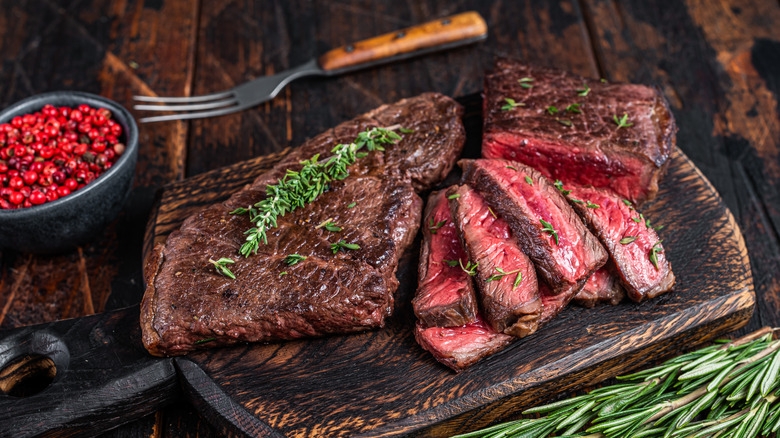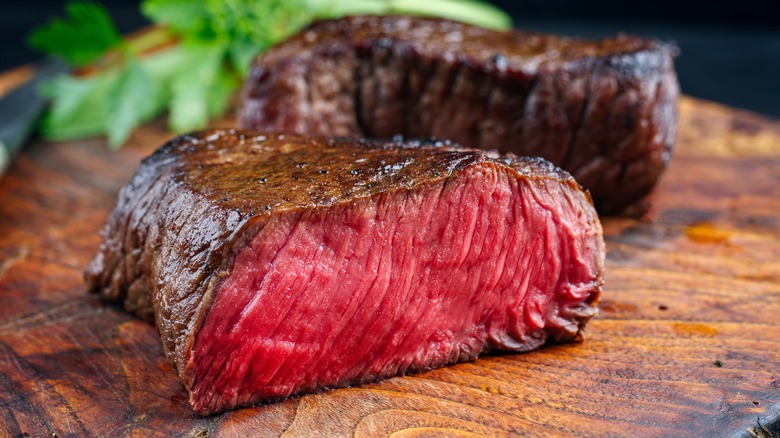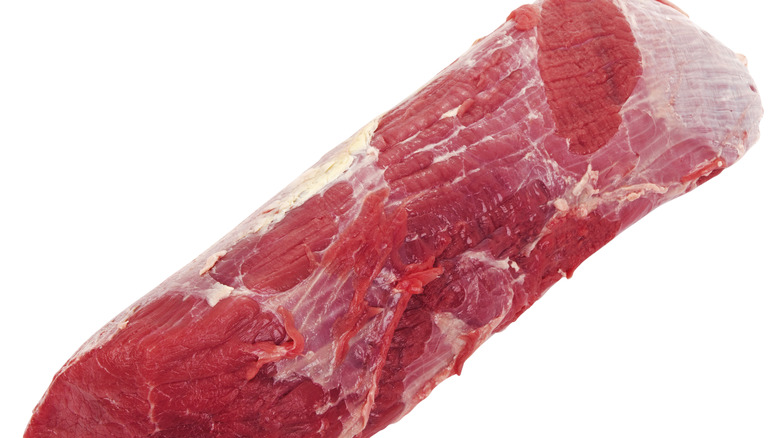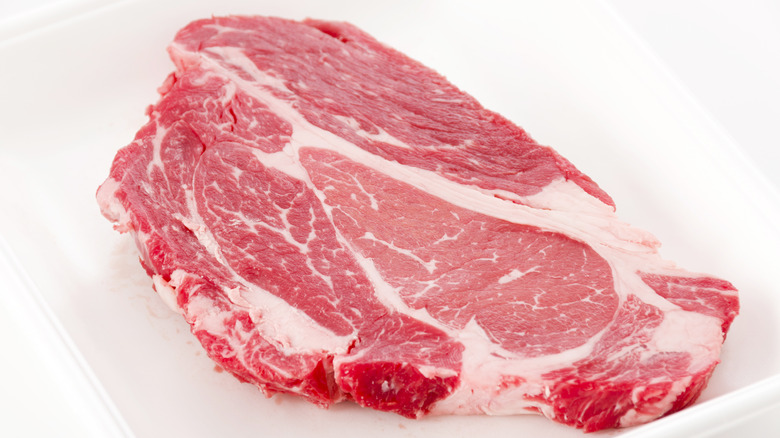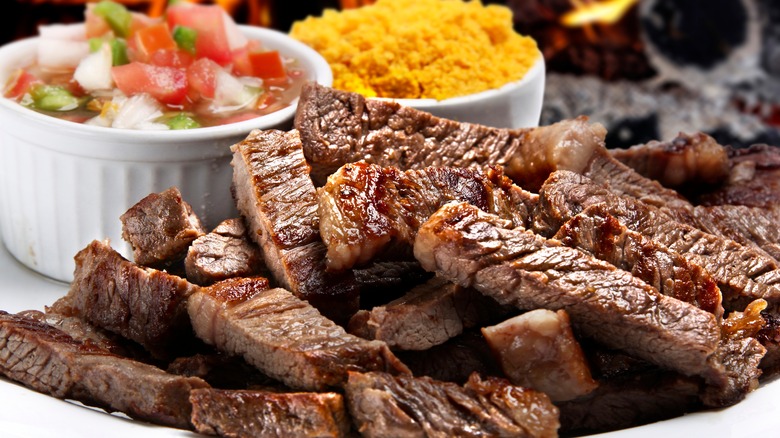The 8 Best Steak Cuts For Marinating, According To A Chef And Butcher
The act of marinating steaks is viewed with equal parts reverence and distrust, though both may be born from people not entirely understanding the process. Marinade composition has three parts: acid, fat, and flavoring. Acid breaks down tough muscle fibers. Fat transports moisture and fat-soluble flavoring components. And flavoring — such as herbs, spices, or sweet elements — absorbs deeper into the steak than simply applying them to the surface given the time and physical reactions involved.
Of course, not every steak benefits from marinating. If you look at the purpose of marinating, it's to break down tough muscle fibers and infuse flavor. If a steak is naturally tender and flavorful, then, it's a waste of time and ingredients to marinate it — and may even be a disservice to the steak. A ribeye, for instance, has different musculature that's plenty tender and flavorful sans marination.
Still, several popular and commonly encountered steak cuts are made better by the tenderizing and flavoring process. I was a chef for decades who's done extensive whole-animal butchering (from fish to cattle). Consequently, I have up-close knowledge of a cow's musculature and how that translates into a good steak — meaning I'm eminently suited to help you discover which steaks benefit most from a marinade. Whether from the grocery store or butcher shop, here are the eight best steak cuts for marinating.
Flank steak
Flank steaks come from below the loin and sirloin. If we were to translate this to human anatomy (side note: please don't butcher a human), the flank would be located in the lower abdomen between your navel and hips. The flank is a flat plate of stringy muscle with very little intramuscular fat (commonly called marbling), which makes sense given its purpose in the cow. After all, the more a muscle is used, the more fibrous it is — and the flank gets worked.
The lack of fat means marinating is key to cooking a flank steak that's tender rather than tough. This steak cut requires fast, hot cooking, and the infusion of moisture from your marinade's liquid ingredients helps mitigate any moisture loss from the heat. Additionally, the long strands of muscle fiber in flank steak need to be addressed, and the acidic elements of a marinade go to work by denaturing them.
Denaturing is a reaction where long muscle fibers unwind and tenderize. Since lemon juice or vinegar are both acidic enough to work quickly on a flank steak, you don't need to marinate it overnight to reap the benefits. In fact, allowing a tough cut of steak to sit in an acidic marinade for too long results in mushy meat, so try to avoid marinating a flank for more than several hours before cooking.
Tri-tip
A triangular cut from the bottom sirloin (which sits directly above the flank), the tri-tip has been the centerpiece of California barbecue for quite some time. The whole tri-tip is the de-facto meat of California's Santa Maria-style BBQ, after all — akin to pork butt with Carolina BBQ, or Texas-style brisket. But the tri-tip is popular outside the Golden State, as well.
Tri-tip steaks are cut from the whole tri-tip and tend to be about an inch thick. Because of the muscle's purpose, its fibers are long and frequently change direction, resulting in a web of dense strands. Given this, finding a tri-tip steak properly cut across the muscle's grain is important, as this shortens the strands to make the steak more tender. Marinating the remaining tough muscle fibers in acid helps to denature and tenderize the tri-tip before it hits the grill.
Additionally, though there's a fair amount of surface fat and marbling on a tri-tip, the added moisture from marinating ensures the steak isn't tough once cooked (provided it receives a hot sear and medium heat finishing). Tri-tip isn't lacking in flavor by any means. But when looking at it as a choice pick for BBQ, it benefits from a smoky cooking treatment. Consequently, infusing flavor via the marinade's ingredients will help enhance this steak cut's natural beefy flavor once it hits your plate.
Skirt steak
There are two different types of skirt steak, and it's safe to treat them similarly. Each comes from the plate primal cut, which sits below the rib and chuck (and can safely be considered the cow's abdomen). The inside skirt steak is shorter than its outside counterpart and is taken from the transversal abdominal muscle. The outside skirt steak is longer and thicker than the inside and is, succinctly, the cow's diaphragm muscle. Each cut of skirt steak contains a smattering of surface fat after trimming, though the outside has a little more intramuscular fat than the inside.
Now, long muscles (like those on both types of skirt steak) and minimal marbling mean a steak is a prime candidate for marinating — and skirt steak is no exception. In that sense, the best way to ensure skirt steak doesn't come out chewy and remains moist is to cook it hot and fast after marinating. You'll want to slice them across the grain, too, to maximize this steak cut's tenderness.
The outside skirt steak is more popular for commercial use in dishes like fajitas or churrasco, so you'll encounter the inside skirt more frequently at the grocery store. Then again, since there are only two of each type of skirt steak per cow, neither is as common in the meat section as a ribeye or New York strip, which are cut from larger pieces (meaning there are more of them by default).
Sirloin filet
A sirloin filet shares little in common with what's typically marketed in shorthand as a "filet." For starters, a "filet" is merely a truncated script for a filet mignon cut from the tenderloin, which runs along the inside top of the cow's rib cage. The sirloin filet, on the other hand, is cut from the sirloin primal (which is almost adjacent to the tenderloin outside the rib cage). While the sirloin filet and tenderloin share a torpedo-like shape and lack of marbling, their similarities start to dwindle from there — and explain why the sirloin filet is ideal for marinating.
For one thing, the sirloin is extensively used by the cow as an exterior muscle, making it far tougher than some other steak cuts. Its muscle fibers may be more densely packed and not as fibrous as the tri-tip, but a sirloin filet still benefits from a marinade in a similar manner as its neighboring cut. Seeing how most of the fat is on the surface of a sirloin filet, as well, it's no mystery how the acid, moisture, and fat from a marinade could remedy any circumstances that might render your sirloin filet tough and dry.
Round steaks
The leg and hip of a cow is called the round primal. The round gets separated into top and bottom parts, but any steaks cut from this primal can be treated the same way when it comes to marinating. After all, while there's a fair amount of fat between these muscle groups, the meat of the round is typically among the leanest cuts of steak – meaning it will dry out quickly and won't have a pronounced flavor if prepared improperly.
Since the round muscles see frequent use within the cow, round steaks are naturally stronger and tougher (thus denser and chewier). Naturally, these tough, lean pieces of meat are picture-perfect for marinating. Actually, in the case of round steaks, a bit of tenderizing with a needle-tipped mallet helps the marinade permeate faster.
Whether you choose to tenderize round steaks or not, you'll want to dedicate several hours to marination time with these dense steak cuts. You'll also want to give them a high-heat sear after marinating because of this denseness — before lowering the heat to allow them to come up to your desired temperature.
Eye round
The eye round is part of the beef round (leg) and sits between the top and bottom round sub-primals — hence the eye or middle. The eye round is a long, almost cylindrical bundle of tightly packed muscles that, left alone, can be an extremely tough cut of steak. But treated well, the eye round can turn into a great steak — which explains why it's one of the more underrated cuts of steak for grilling.
Butchers usually cut eye round steaks an inch or two thick, shortening the fibers' overall length and mitigating some of the steak's chewiness. However, it's still a very lean cut with a thin fat cap across its top surface and next to no marbling. Since the lack of marbling means the eye round isn't going to pack a lot of beef flavor, either, marinating these steaks is a very good idea.
Between its leanness and long-stranded musculature, be sure to allow plenty of time for a marinade's acid to penetrate your eye round steak. Of course, as we mentioned before, don't marinate steak longer than 24 hours to avoid excessive denaturation of the proteins that turn your steak into a spongy mess.
Chuck steak
The chuck is the cow's shoulder, and inside it? There are some beautifully tender steaks, like the chuck eye and the flat iron. However, the typical chuck steak is a cross-cut piece that's taken from directly next to the shoulder blade — meaning it doesn't have the qualities of those tender steaks. In other words, a chuck steak is an ideal candidate for marinating before cooking.
A typical chuck steak resembles several segmented pieces held together to form one solid piece. Those segmentations are veins of fat and connective tissue. Now, the fat is good, as it helps keep the meat moist and provides a beefy flavor. But the connective tissue tends to be gristly and chewy. Furthermore, the individual muscle groups that make up these supposed segments see a lot of use when a cow walks.
Since they tend to be tough as a result, tenderizing is in order. A well-seasoned, herbaceous, acidic marinade will add depth of flavor to the meat while concurrently breaking down some of that tough, unappetizing connective tissue. Additionally, the muscles from the chuck aren't as dense as those from the round, so a chuck steak will absorb the marinade quicker than a round steak.
Picanha
A picanha steak is a surprisingly tender piece of beef cut from the sirloin and is a staple in Brazilian steak houses. It sits at the top of the cow's back, bridging between the sirloin and rump, so it receives some use — but not as much as the leg, chuck, or other cuts lower on the sirloin. This means it's got some natural tenderness and doesn't necessarily require the tenderization offered by a marinade. Still, marinating doesn't detract from its flavor and can be useful.
One of the main benefits of marinating a picanha steak is to infuse it with additional flavors. There's a thin fat cap on the cut, which also instills some moisture, but enhancing it with additional fat and a strong concentration of herbs makes it more moist and compliments the already beefy taste.
In this case, you'll want to use a marinade that contains a less acidic component, as well, such as citrus instead of vinegar. You don't need to severely denature the muscle proteins in a picanha steak in order to make it tender, after all. No matter your marinade recipe, the best way to cook this popular cut of beef is by grilling.
